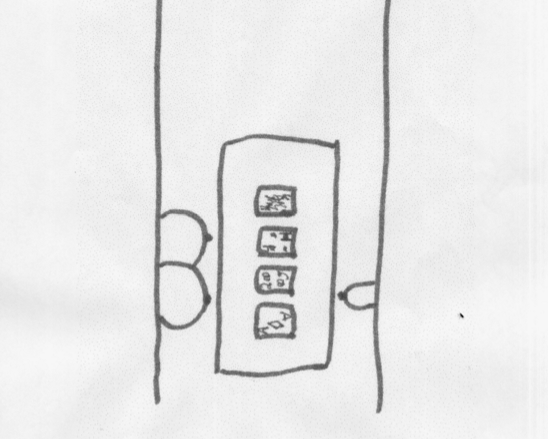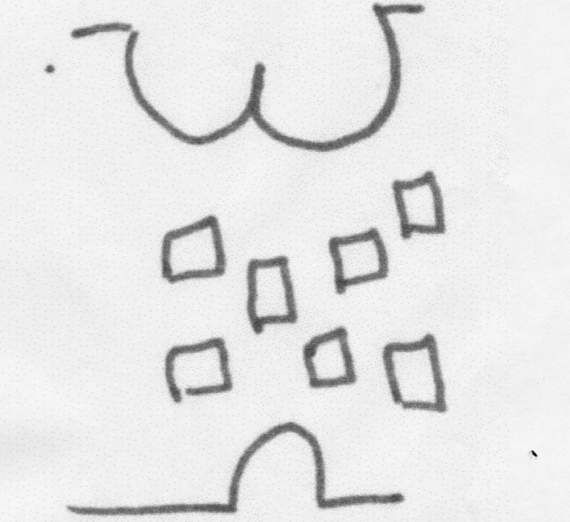"Droodle Me This ... ": Pictorial Declarations and the American Dream Maria Teresa Agozzino
Drawing the American Dream
As microcosms of American worldview, American droodles encode American values, norms, ideals, anxieties, and aspirations, generally speaking. The essential American dream, that hard work, courage, and determination will be rewarded with home ownership, upward mobility, equality, and personal freedoms is commonly commodified as bigger and better houses, vehicles, sports teams, pay checks, and accolades (Cullen). Success and happiness may be measured in terms of material gain, as seductively modeled by Hollywood celebrities and Las Vegas glitz. As Dundes points out, "Every culture's legends express that culture's values," and, "The idea of big numbers, of being bigger than other people, is very American" (qtd. in Emery).
The 'bigger is better' mantra has morphed into an acceptance of quick fixes and short cuts, which have manifested in an instant fan base for quiz-show winners, cheeky hustlers, and underdogs (Warshauer)  -- consider the reaction to a surprise win by an outsider or 'Cinderalla team,' such as George Mason University's 2006 NCAA basketball championship victory (George Mason), and the response to the 2006 lottery success of eight Nebraska meat packers (O'Hanlon). The American preponderance to exaggeration (Emery) parallels an admiration for those who make the impossible possible, whether beating the odds or defying nature.
-- consider the reaction to a surprise win by an outsider or 'Cinderalla team,' such as George Mason University's 2006 NCAA basketball championship victory (George Mason), and the response to the 2006 lottery success of eight Nebraska meat packers (O'Hanlon). The American preponderance to exaggeration (Emery) parallels an admiration for those who make the impossible possible, whether beating the odds or defying nature.
Figure 6: "Aerial View of Dolly Parton and Betty Ford Playing Cards."
The following droodle (Figure 6) illustrates how an obsession for bigger has colored perceptions of beauty and fueled a consequent willingness to transform the body in order to conform to unnatural but reigning aesthetic standards. As Debra L. Gimlin explains, "strategies for surgically altering the body's appearance have been available for centuries, [but] the practice has only recently become a mass phenom- enon" (76), with many women focusing "enormous energy on molding their bodies into the closest possible approximations of the female ideal" (17). A plethora of versions include Dolly Parton and Betty Ford alternately playing backgammon, poker, strip poker, double-handed solitaire, bridge, gin rummy, and checkers. [15]
As an international music star, Dolly Parton and her famous protuberances are reasonably identifiable. However, the droodle cannot be solved without some acquaintance with First Lady Betty Ford (1974- 1977), and her battle with breast cancer and subsequent mastectomy, which provides a terminus post quem of 1974. Betty Ford was born in 1918 and Dolly Parton in 1946, it is unlikely that they met and even less that they would play parlor games together.
 Variants include aerial depictions of Betty Ford and First Lady Nancy Reagan playing cards, drawn with one breast each. [17] Born in 1921, Nancy Reagan underwent a mastectomy in 1987. Both Betty Ford and Nancy Reagan promoted health and medical concerns, and Betty Ford particularly championed the fight against breast cancer. A San Francisco variant shows Betty Ford playing cards with Carol Doda, a local character of striptease fame (Figure 7). [18]
Variants include aerial depictions of Betty Ford and First Lady Nancy Reagan playing cards, drawn with one breast each. [17] Born in 1921, Nancy Reagan underwent a mastectomy in 1987. Both Betty Ford and Nancy Reagan promoted health and medical concerns, and Betty Ford particularly championed the fight against breast cancer. A San Francisco variant shows Betty Ford playing cards with Carol Doda, a local character of striptease fame (Figure 7). [18]
Figure 7: "Looking Down on Betty Ford and Carol Doda." [16]
The droodles of Dolly Parton et cetera are surely cognate with earlier cycles that depict popular pin-ups Jayne Mansfield and Marilyn Monroe (both characterized by large breasts) either talking19 or playing checkers. [20] All of the texts clearly target women with large breasts; not one droodle highlighting small breasts was collected. Clearly, stereotypes about expectations of beauty and sex appeal, [21] and women's anxieties about the social consequences of breast size are encoded in anonymous and traditionally transmitted droodles. Furthermore, these droodles humanize public figures, and in doing so present an amalgam of anxieties surrounding, not only an increasing dependence on surgical augmentations to achieve societal values of beauty, but also document an increasing awareness and well-warranted fear of breast cancer. But why are the celebrity women under the microscope, so to speak, drawn from above and depicted gaming? I suggest that it presents a God's eye-view of a world where, like a poker hand, breast size and breast cancer are determined by chance.
Maria Teresa Agozzino has a Ph.D. in Folklore and Celtic Studies from the University of California, Berkeley, where she served as Head Reader for Alan Dundes from 1999-2004 and as Head Archivist from 2000 to 2004. She has taught folklore and American Studies courses at UC Berkeley and California State University, East Bay. Her publications include "Welsh Calennig and Greek Kalanda: Begging in the New Year," Cosmo: The Journal for the Traditional Cosmology Society 19 (2005): 21-45, "Ysbryd y Werin: An Overview of Celtic Folklore Scholarship," The Folklore Historian 22 (2005): 13-33, and "First Come, First Served: Investigating Sir John Rhys' 'Essential Connexion' between Celtic New Year Customs." Studi Celtici: An International Journal of History, Linguistics, and Cultural Anthropology 2 (2003). This paper evolved from a guest lecture presented to an introductory American Studies course at UC Berkeley in fall 2005. She is much obliged to Christine Palmer for the opportunity.
